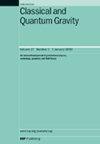在引力波探测器原型设施中测试基于熔融硅谐振器的紧凑惯性传感器
IF 3.7
3区 物理与天体物理
Q2 ASTRONOMY & ASTROPHYSICS
引用次数: 0
摘要
未来的引力波观测站需要在地震隔离的各个方面取得重大进展;惯性传感器就是一个很好的例子。采用克级高机械Q因子(Q)玻璃谐振器结合紧凑的干涉读数的惯性传感器是千克级传统惯性传感器的有希望的替代品。我们已经生产了适用于低频惯性传感的熔融硅谐振器,并证明了Qs超过150000是可能的。我们生产的一个谐振器与一个纯差正交干涉仪(HoQI)相结合,读取测试质量位移,形成惯性传感器。这是HoQI首次与高Q谐振器一起使用。所得到的传感器在AEI 10 m原型设施中与其他商用公斤级惯性传感器进行了测试。尽管测试质量运动引起了动态范围的挑战,但我们可以将hoqi迄今为止取得的优秀噪声底与缓慢移动或静止测试质量相匹配,这表明hoqi是此类传感器读出的优秀候选者。我们将该装置作为惯性传感器进行评估,显示出迄今为止任何克级传感器所展示的最佳性能,其灵敏度可与当今引力波探测器中使用的体积较大的传感器相媲美。这些传感器具有紧凑的尺寸,自校准和真空兼容性,使其成为未来引力波探测器惯性传感要求的理想候选者。本文章由计算机程序翻译,如有差异,请以英文原文为准。
Testing compact, fused silica resonator based inertial sensors in a gravitational wave detector prototype facility
Future gravitational wave observatories require significant advances in all aspects of their seismic isolation; inertial sensors being a pressing example. Inertial sensors using gram-scale high mechanical Q factor (Q) glass resonators combined with compact interferometric readout are promising alternatives to kilogram-scale conventional inertial sensors. We have produced fused silica resonators suitable for low frequency inertial sensing and demonstrated that Qs of over 150 000 are possible. One resonator we produced was combined with a homodyne quadrature interferometer (HoQI) to read out the test mass displacement to form an inertial sensor. This is the first time a HoQI was used with a high Q resonator. The resulting sensor was tested against other commercial, kilogram scale inertial sensors at the AEI 10 m Prototype facility. Despite the dynamic range challenges induced by the test mass motion, we can match the excellent noise floors HoQIs have achieved so far with slow-moving or stationary test masses, showing HoQIs as an excellent candidate for the readout of such sensors. We evaluate the setup as an inertial sensor, showing the best performance demonstrated by any gram-scale sensor to date, with comparable sensitivity to the significantly bulkier sensors used in gravitational wave detectors today. These sensors’ compact size, self-calibration, and vacuum compatibility make them ideal candidates for the inertial sensing requirements in future gravitational wave detectors.
求助全文
通过发布文献求助,成功后即可免费获取论文全文。
去求助
来源期刊

Classical and Quantum Gravity
物理-天文与天体物理
CiteScore
7.00
自引率
8.60%
发文量
301
审稿时长
2-4 weeks
期刊介绍:
Classical and Quantum Gravity is an established journal for physicists, mathematicians and cosmologists in the fields of gravitation and the theory of spacetime. The journal is now the acknowledged world leader in classical relativity and all areas of quantum gravity.
 求助内容:
求助内容: 应助结果提醒方式:
应助结果提醒方式:


